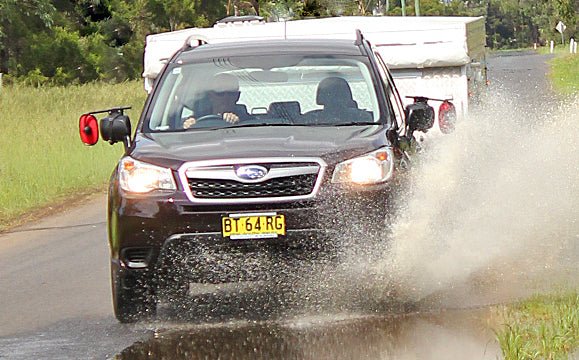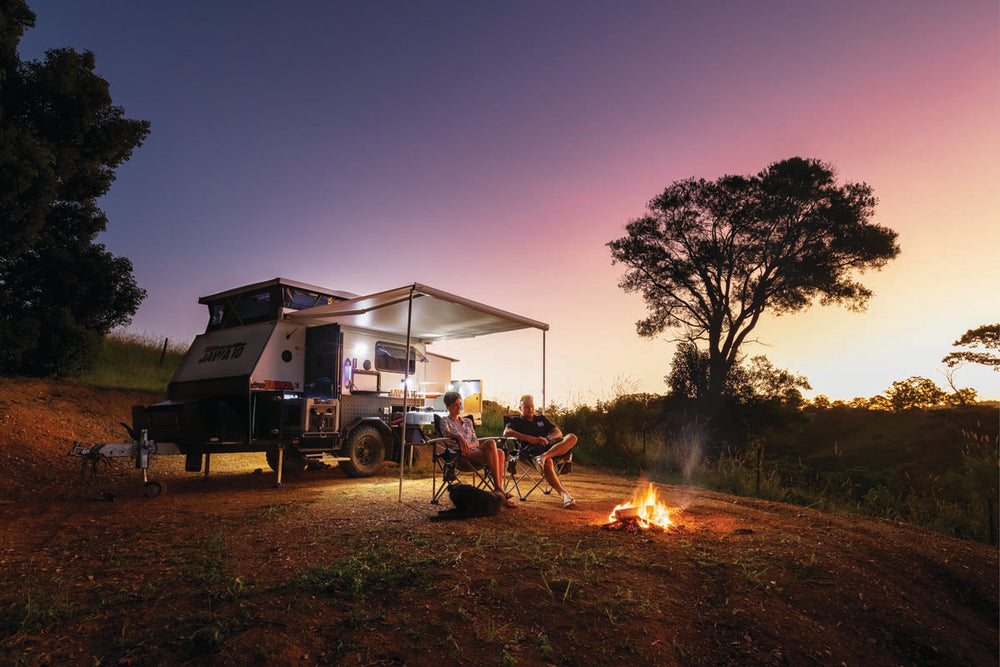Subaru Forester 2 Tow Vehicle Review

The fourth generation Subaru Forester has arrived and the key changes that will be of interest to caravanners are the increased maximum towing capacity and the trailer sway control, which is now incorporated into the electronic safety suite.
These features complement a raft of more significant general changes, such as CVT transmission (replacing the antiquated four-speed auto), auto stop-start, a weight-saving aluminium bonnet and a sophisticated trip computer.
The entry level Forester is the six-speed manual 2.0 but we are testing the more popular automatic version, the 2.5i. The automatic – strictly speaking, it’s a Constantly Variable Transmission (CVT) – is a first for the Forester, replacing the four-speed automatic in the previous model and, unlike before, Subaru has seen fit to use a larger displacement engine when the CVT option box is ticked. Instead of the 110kW/198Nm 2L engine, the CVT uses a 126kW/235Nm 2.5L engine.
ATTRIBUTES
Standard features in the Forester 2.5i include auto stop-start, X-Mode (offroad mode) seven airbags (including driver’s knee airbag) ABS brakes, traction control and stability control, electric drop-down rear seats, dual-zone climate control air-conditioning, trip computer, Bluetooth for phone, audio streaming and with voice recognition, manual, height-adjustable driver’s seat, AC powerpoint in the front console and roof rails.
The Forester’s cabin is wider than before and the seats are positioned higher for a better hip point. And the redesigned sills, which sit slightly inboard, make getting in and out easier.
The windscreen sits forward 200mm over the previous model and this helps the feeling of spaciousness in the Subaru’s cabin. Subaru has also spent money on soft-touch plastics, aiding a better sense of quality inside.
The front seats are firm and supportive, although you do get the feeling you are perched higher up than before. The way Subaru has incorporated a more raked windscreen and fixed side window quarter glass has not only improved vision to the sides when waiting at an intersection, for example, but you have a much better view when actually turning. Such a simple change has yielded great results.
The controls are mostly unremarkable, which is a good thing. The comprehensive trip computer, which includes – among
a long list of other features – the amount of fuel saved by using the stop-start system, takes a while to learn to use. Other than that, this is one of those cars that you just jump in and drive, without fumbling about.
The rear seat is comfortable and offers plenty of leg and head room. The seat is adjustable for rake, not only improving comfort for adults, but also permitting a more secure fitment of child or booster seats. These seats don’t always sit flush with the back of the seat and this rake adjustment allows a better fit.
The cargo area is large with tie-downs and with neat shopping hooks fitted to the side walls. The full-sized spare wheel is under the cargo floor.
ENGINE AND TRANSMISSION
The 2.5L engine is a new generation of Subaru’s horizontally opposed four-cylinder engine and it is smoother and quieter than before. This engine is tractable and revs out without fuss. The auto stop-start system is more sophisticated than early examples of this feature used in other brands, with a quicker response time in restarting the engine, albeit with a bit of a jolt.
What really makes this engine sing is, perhaps, less to do with the engine characteristics and more to do with the excellent transmission. The CVT designs have been around for a long time but few and far between are the ones that work well. Chosen for their superior efficiency, even when compared with a manual transmission in some cases CVTs don’t always prove much fun to drive. Typical is a lack of responsiveness, a tendency to stay high in the rev range to produce power and for the engine to sound strained while doing so. This CVT is nothing like that. On easy suburban runs, it is quiet and unobtrusive and all the while responsive to throttle input. Put your foot down and it responds almost as a turbodiesel would – that is, with a sense of plenty of low-down torque, followed by a strong power delivery as the revs rise. Although it does reach high into the rev range to gain peak power, as you’d expect, it doesn’t sound like the engine might explode while doing so.
The all-wheel-drive system is split 60:40 front:rear and is varied electronically according to wheel slip.
SUSPENSION
The Forester employs a conventional independent coil spring suspension with front struts and rear wishbones. Power steering is with electric, rather than hydraulic, assistance, and Subaru says despite an increase in wheelbase by 25mm, the new Forester maintains the same 10.8m turning circle of the previous generation.
The Forester rides well with some thump over sharp bumps but the road shocks are generally very well contained. Over more undulating bumps the Subaru can feel a little soft, but it is still well contained with no nasty surprises. The Subaru’s dynamics are very good for a tall SUV, with a chassis that responds well to steering input.
ECONOMY
Subaru says the new Forester is 12.9 per cent more efficient than the four-speed auto 2.5L it replaces and that its average fuel use is 8.1L/100km. On test, we averaged more like 10.0L/100km, although it was more weighted to urban use than intra-urban. On a highway run, we averaged 8.2L/100km. While towing an 1160kg caravan, we averaged 14.4L/100km.
TOWING
The Forester took on towing duties very well. The 1160kg van we towed, with a 110kg towball download, didn’t really upset the Forester at all. Stability was very good, with little in the way of sway or pitching. The rear of the Subaru sat a little lower than its unladen ride height but this did not affect how it towed.
Performance was quite good – although no powerhouse, the Subaru would respond to throttle input quite well and steep hills did not really phase it. The engine braking through the CVT was not perhaps as effective as a conventional automatic may have been.
THE BOTTOM LINE
The changes to the new Forester feel, in many ways, incremental. Certain technologies, such as the CVT, have been added to very good effect but, in most other ways, the Forester appears to be a refinement of the previous model.
The improvements of note are that it is easier to get in and out of and to see out of, the trailer sway control is standard and that towing capacity is better. Fuel economy is not outstanding and neither is the engine braking when towing but, in the general picture, these are minor complaints. The new Forester is a good thing.
SPECIFICATIONS: SUBARU FORESTER 2
Engine Horizontally opposed
four-cylinder petrol
Max power 126kW at 5800rpm
Max torque 235Nm at 4100rpm
Transmission Constantly Variable Transmission
Length 4595mm
Width 1795mm
Height 1735mm
Wheelbase 2640mm
Ground clearance 220mm
Kerb Mass 1528kg
Gross Vehicle Mass 2055kg
Gross Combined Mass 3555kg
Fuel tank capacity 60L
Roof load 80kg
Towing capacity unbraked/braked 750kg/1500kg
TBM maximum 150kg
More information www.subaru.com.au.
Originally published in Caravan World #513, April/May 2013.







